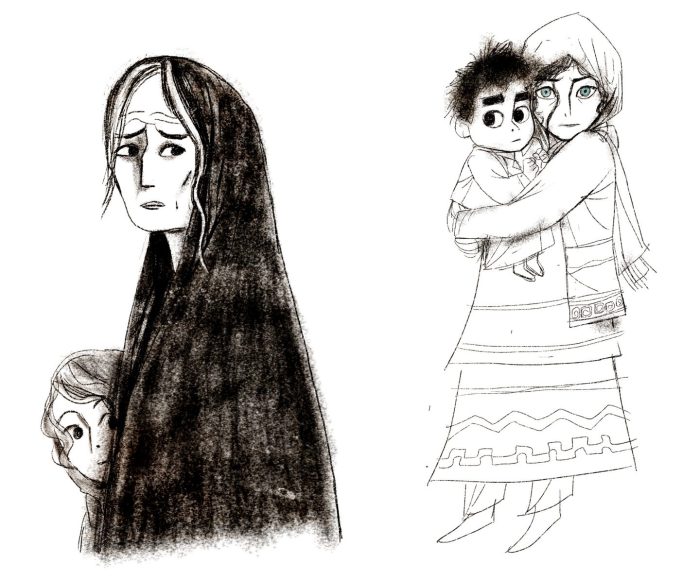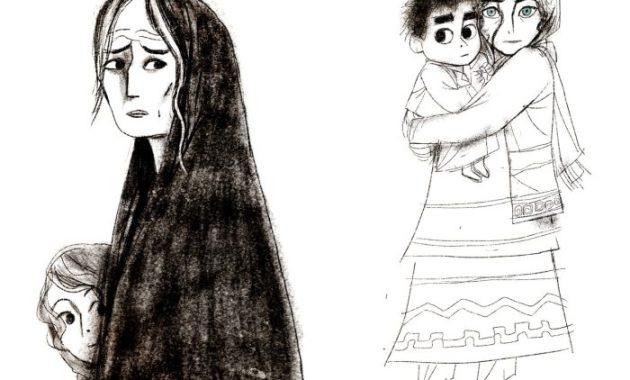Parvana’s Role as Breadwinner

Breadwinner drawing easy parvana – Parvana’s journey as the breadwinner in her family transcends a simple narrative of survival; it’s a profound exploration of resilience, sacrifice, and the indomitable spirit of a young girl forced to confront the harsh realities of war and societal expectations. Her story resonates deeply, offering a glimpse into the strength found within vulnerability and the transformative power of responsibility.Parvana’s Motivations for Becoming the Family’s Primary ProviderParvana’s father, a respected teacher, is imprisoned under the Taliban regime, leaving her family destitute and vulnerable.
Her mother, weakened by illness and grief, is unable to provide for her younger siblings and herself. This desperate situation compels Parvana, despite her young age, to assume the role of breadwinner, driven by an unwavering love and fierce loyalty to her family. Her motivation stems not from ambition or personal gain, but from a primal need to protect and nurture those she cherishes most.
This selfless act becomes her spiritual path, a testament to the enduring power of familial bonds in the face of adversity.Challenges Faced by Parvana as BreadwinnerParvana’s role is fraught with challenges, both societal and economic. The societal constraints imposed by the Taliban regime severely limit her opportunities. She faces discrimination as a girl working in public, constantly battling prejudice and the risk of violence.
Economically, she struggles to earn enough to provide for her family’s basic needs, facing exploitative employers and precarious working conditions. The constant threat of hunger and the struggle to secure even the simplest necessities are constant companions on her journey. She must navigate a treacherous landscape, where her gender and age place her at a significant disadvantage.Comparison with Other Female BreadwinnersParvana’s experiences resonate with countless women throughout history and across cultures who have shouldered the burden of providing for their families.
Think of the countless mothers working tirelessly in sweatshops or informal economies globally, often facing similar hardships and societal biases. The strength and determination displayed by women in these situations, like Parvana’s, are remarkable testaments to human resilience. Fictional characters such as Jo March fromLittle Women*, although facing different societal challenges, similarly display resourcefulness and a dedication to providing for their loved ones.
Parvana, the breadwinner, sketched her weary world in simple lines, a testament to resilience. Her artistic spirit, mirroring the boundless road, yearned for escape, a vision perhaps fueled by finding a easy drawing of a camper van , a symbol of freedom and adventure. Back to her charcoal, Parvana continued her poignant narrative, each stroke a whispered prayer for a better tomorrow.
These narratives highlight the universality of the struggles faced by female breadwinners and the enduring power of their contributions.Impact of Parvana’s Work on Personal Development and Family RelationshipsParvana’s experiences profoundly shape her personal development. She matures rapidly, forced to navigate complex social and economic situations far beyond her years. Her resilience is tested repeatedly, yet she emerges stronger and more self-reliant.
The responsibility she carries also impacts her family dynamics. While her work brings economic stability, it also strains her relationship with her mother and siblings, as she is often away from home and burdened by the weight of her responsibilities. This highlights the complex interplay between familial love and the demanding realities of survival. The family’s bond, however, remains a crucial source of strength and support, even amidst the hardships.
Parvana’s Resilience and Agency

Parvana’s journey in Breadwinner is not merely a story of survival; it is a testament to the indomitable human spirit’s capacity for resilience and the quiet power of agency even in the face of overwhelming adversity. Her experiences offer a profound meditation on the strength found within, the transformative power of resourcefulness, and the enduring spirit that challenges societal norms.Parvana’s unwavering perseverance stems from a deep-seated love for her family and an unwavering commitment to their well-being.
This fierce devotion fuels her actions, providing the inner strength necessary to navigate the treacherous landscape of war-torn Kabul. Her resilience isn’t passive endurance; it’s an active, dynamic force shaped by her intelligence, adaptability, and unwavering determination.
Key Traits Enabling Parvana’s Perseverance
Parvana’s resilience is built upon several foundational pillars. Her sharp intellect allows her to quickly assess situations, devise strategies, and adapt to changing circumstances. Her courage, often masked by a pragmatic exterior, enables her to take risks and face dangers head-on. Furthermore, her resourcefulness, honed by necessity, allows her to utilize available resources creatively and efficiently. Finally, her deep empathy and compassion for others, even amidst her own struggles, underscore her moral compass and provide an unwavering sense of purpose.
Instances of Parvana’s Resourcefulness and Ingenuity
Parvana’s resourcefulness is evident throughout her narrative. Disguising herself as a boy allows her to earn money and support her family, a decision born from necessity and executed with remarkable cunning. Her ability to navigate the complex social dynamics of Kabul’s streets, negotiating with customers and avoiding dangerous situations, showcases her practical intelligence. The way she uses her limited resources to provide for her family, bartering and trading to acquire necessities, demonstrates a level of ingenuity beyond her years.
Even her storytelling skills, used to both entertain and earn a living, highlight her creative adaptability.
Comparison of Parvana’s Agency to Other Characters
In contrast to other characters, particularly the women in her life who are largely confined by societal expectations and limited by the patriarchal structure of their society, Parvana actively shapes her own destiny. Her mother, Nooria, and sister, Maryam, are largely passive, their agency restricted by the constraints of their gender and the oppressive environment. Parvana, however, actively challenges these limitations, choosing to act rather than be acted upon.
This proactive approach contrasts sharply with the more passive roles of other female characters, highlighting the exceptional nature of Parvana’s agency.
Parvana’s Challenge to Traditional Gender Roles
Parvana’s actions directly challenge deeply ingrained gender roles. By disguising herself as a boy and taking on the traditionally male role of breadwinner, she subverts societal expectations and demonstrates the inherent capabilities of women often overlooked or suppressed. Her actions are a powerful statement against the limitations imposed upon women in her culture, highlighting the hypocrisy of a system that restricts women while simultaneously relying on their contributions.
Her resilience and success in this male-dominated role serve as a potent symbol of female empowerment and a challenge to the status quo.
The Impact of Parvana’s Work on Her Family

Parvana’s transformation from a sheltered child into the family’s sole provider profoundly reshapes the emotional landscape and power dynamics within her household. Her work, born of necessity, carries a heavy weight of responsibility that reverberates through every interaction, every shared meal, every whispered hope. The family’s survival hinges on her strength, resilience, and unwavering commitment, yet this very strength comes at a cost, etched in the lines of worry on her face and the silent burdens she carries.Parvana’s work directly impacts the emotional well-being of her family members in multifaceted ways.
The constant anxiety of providing enough food and shelter weighs heavily on her mother, whose frail health is further strained by worry. Her younger siblings, once carefree, now bear the weight of their circumstances, understanding implicitly the sacrifices Parvana makes for them. While their father’s imprisonment casts a long shadow, Parvana’s efforts provide a flickering flame of hope, a tangible demonstration that they can survive.
The fear of starvation and homelessness, ever-present before Parvana’s intervention, is now replaced with a fragile but persistent sense of security.
Changes in Family Dynamics
Parvana’s role as breadwinner fundamentally alters the family’s dynamic. The traditional patriarchal structure, already weakened by the father’s absence, is replaced by a matriarchal model, albeit a young and burdened one. Parvana, forced to mature beyond her years, assumes a position of authority, making critical decisions regarding the family’s well-being. This newfound responsibility brings a sense of purpose and strength, but also isolates her from the carefree aspects of childhood.
Her siblings, witnessing her unwavering dedication, develop a profound respect and reliance on her, creating a bond forged in shared hardship and mutual survival. The family’s dependence on Parvana, while essential for survival, also carries the potential for resentment or strain if she is unable to meet their needs consistently. The family’s shared struggle, however, fosters a deeper understanding and appreciation for each other, a unity built on mutual reliance and shared sacrifice.
Parvana’s Efforts and Family Survival, Breadwinner drawing easy parvana
Parvana’s efforts are not merely about procuring food and shelter; they are a testament to her unwavering determination to keep her family together and alive. Each day, she braves the dangers of Kabul’s streets, facing harassment and exploitation with quiet courage. Her earnings, though meager, represent a lifeline, providing the bare necessities that sustain them. Beyond the material provisions, her actions inspire hope and resilience in her family.
Her willingness to sacrifice her own well-being for her family’s survival demonstrates a love and commitment that transcends the hardships they face. This quiet heroism, witnessed daily by her family, becomes a source of strength and inspiration, reminding them that even in the face of overwhelming adversity, hope persists.
A Narrative Example: The Winter Coat
The harsh Kabul winter threatened to consume the family. Their meager possessions offered little protection against the biting cold. Parvana, already exhausted from her day’s work reading for others, noticed her younger sister Nooria shivering uncontrollably, her thin shawl offering little warmth. That night, Parvana made a difficult decision. She would forego her own meager meal, sacrificing her already limited strength, and use the saved money to buy Nooria a warm winter coat.
The next day, braving the icy wind and snow, she scoured the market until she found a well-worn but sufficiently warm coat. Seeing Nooria wrapped in the coat, her face glowing with warmth and relief, Parvana felt a surge of immense satisfaction. This small act of sacrifice, born from her unwavering dedication as breadwinner, transcended the material; it represented the profound love and unwavering commitment that held her family together during the darkest of times.
It was a quiet victory, a testament to the power of love and sacrifice in the face of adversity, a symbol of hope amidst the despair.
FAQ: Breadwinner Drawing Easy Parvana
What materials do I need to draw Parvana?
Just a pencil, paper, and maybe an eraser for those inevitable mistakes! We’re keeping it super simple.
Is this suitable for kids?
Absolutely! The drawing instructions are designed to be kid-friendly, and the story of Parvana is a powerful one for young readers to explore.
Are there more complex drawing tutorials available?
While this focuses on “easy” drawings, more advanced techniques could certainly be used to create more detailed portraits of Parvana. The internet is your oyster!
Where can I read more about Parvana’s story?
The book “The Breadwinner” by Deborah Ellis is a fantastic read. You can find it at most libraries or bookstores.

